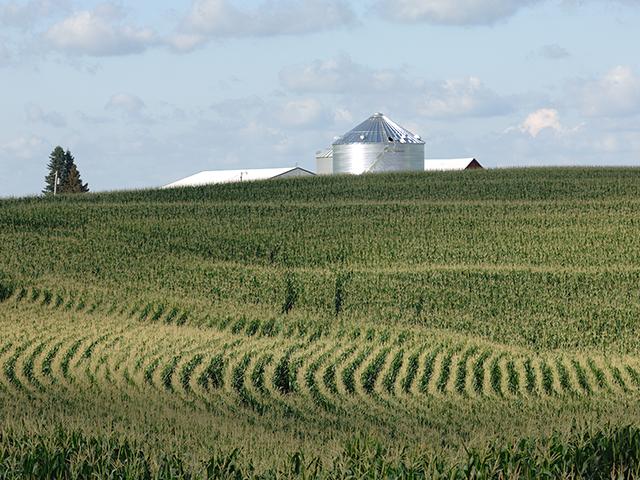Cannibalism of US Farm Ground
Farmland Acres Pressured by Urban Growth and Emphasis on Conservation
America's agricultural land today is being squeezed between a growing population's need for urban growth and pressure to set aside more areas for conservation. Richard Brain calls it a "vice" in a recent report he wrote on the issue, sounding a cautionary note about the impact of these trends on the future of U.S. farmland.
Brain, lead researcher and writer on a report in Agricultural Science and Technology, is an environmental toxicologist with Syngenta Crop Protection, based at Greensboro, North Carolina. He calls the current shift out of farmland a "cannibalistic scenario, whereby expanding urban populations ultimately consume the very land that enabled its expansion."
This newly published report answers in part the question that USDA reports on farmland acreage typically don't. Notably, when farms and farmland acres decline, where does that land actually go?
Brain writes that from 2001 to 2016, 11 million acres of farmland and ranchland were converted to urban and highly developed land use (4.1 million acres) or low-density residential land use (about 7 million acres). To put that in perspective, he found that in the U.S. collectively, there are about 2.3 billion acres of land. Use for this land currently breaks down like this: 29% is permanent grassland, pasture, and range; 28% is forest; 17% is cropland; 14% is special use; 3% is urban; and the remaining 9% is miscellaneous. He describes "special use" as being things like rural transportation, rural parks and wildlife, defense and industrial, and miscellaneous farm.
Brain, who spoke to DTN about his work, said these percentages have shifted over time as needs and society have changed. At one time, he noted, agricultural land made up as much as half of the U.S. total land area. The high productivity of farms enabled society to grow its population, by a factor of 10 over the last 150 years. He specifically attributes that to rural resilience and technological innovation.
"Representing a prosperous first-world society, the U.S. enjoys food security as a direct consequence of extraordinary agricultural productivity, and this productivity is a direct consequence of technology, including mechanization, fertilizers, and pesticides," the researcher said, noting that every system, however, has its limits, and this includes agriculture.
While Brain writes that the apex of agricultural production may not have been fully realized in the U.S. yet, he believes an impasse is inevitable.
P[L1] D[0x0] M[300x250] OOP[F] ADUNIT[] T[]
"As the agricultural landscape shrinks and the quintessential fields that once grew wheat, corn, and soybeans now produce subdivisions, warehouses, and parking lots, perhaps, as a society we should ask ourselves, 'Is this sustainable?'" he said.
Along with rural growth, farmland is increasingly being lost to conservation, a movement Brain noted in which societal interest continues to increase. But given a choice between urban spread and conservation, he says it's definitely easier to revert conservation ground back into agriculture if necessary.
"Shifting back is easier with conservation," he said. "Once farmland is paved over and a subdivision is built, it's irrevocably changed. If you're rewilding a CRP for example, you can always reclaim and revert to production if necessary. But you can't do that with a parking lot."
Lastly, Brain voices questions about actual farmland ownership, noting that nonfarming entities that own land that are generally detached from agriculture, the land, and the associated communities, are increasingly investing in the nation's most precious resource as a commodity.
"Land speculation," he said, "has increased the value of farmland considerably, putting it out of reach for most aspiring farmers."
FARM SECTOR DEBT TIED TO LAND
USDA reported that farm sector debt tied to real estate is expected to come in at a record high of $375.9 billion in 2023. That would be a significant increase over the 10-year average.
The ERS' Farm Income and Wealth Statistics report shows the 10-year average for farm real estate debt (2012-2021) at $282.6 billion. It has been climbing steadily over the last two years. Non-real estate debt, however, has been declining. The 10-year average for that (2012-2021) is $177.2 billion, with 2023 forecast below that average.
Brain told DTN he suspects the higher rate of farm sector debt tied to real estate today is associated with generational succession and turnover of farmland.
"Unless the land is gifted, a debt burden is associated with acquisition and transition, which is also probably why today we see about 40% of ag land leased or rented," he said.
Asked if he is concerned the pendulum has swung too far when it comes to the loss of agricultural land in the U.S., Brain said likely not yet, but added that even with breakthroughs in technology, that is finite and agriculture may be approaching the apex.
"We at some point will need to acknowledge how much pressure we can put on existing land before some degree of compromise has to be reached between society's expectations and food security," he said.
Editor's Note: To read DTN's earlier article on the loss of farmland acres go here: https://www.dtnpf.com/….
Victoria Myers can be reached at vicki.myers@dtn.com
Follow her on Twitter @myersPF
(c) Copyright 2023 DTN, LLC. All rights reserved.






